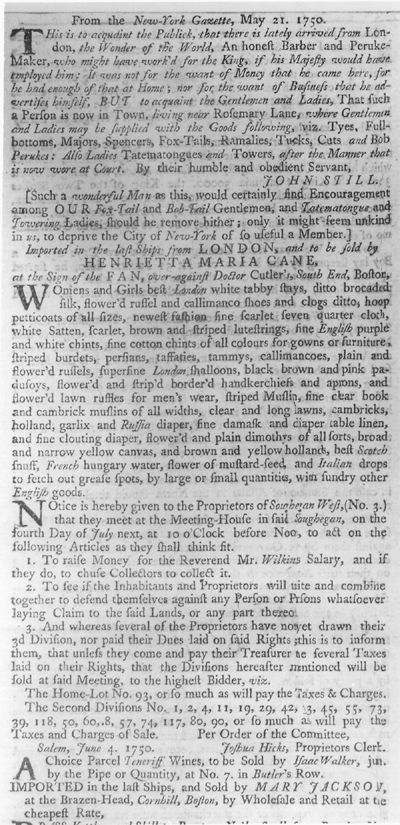
|
|
Mary Jackson, Boston Evening-Post, 11 June 1750, "Shop Advertisement." Mary Jackson's shop in Boston was located just across the street from the Boston Town House, the seat of royal authority in the colony. A regular advertiser in the Boston Evening-Post, Jackson was unusual for a woman shopkeeper in that her merchandise consisted of metal goods, not the imported fabrics and fashionable items more typically found in women retailer's shops. Jackson, who took her son William as her business partner, advertising as "Mary Jackson and Son," became the subject of public notice in March 1760, when a devastating fire broke out in her shop at two o'clock in the morning. That fire, which lasted for three days, destroyed hundreds of wooden buildings in Boston and left many people without property or shelter in its aftermath. A regular advertiser, Jackson was one of only three women to place notices for their shops in the pages of the Boston Evening-Post in the summer of 1750. The other two were Henrietta Maria East Caine and Elizabeth Murray. For more on Mary Jackson, see Patricia Cleary, Elizabeth Murray: A Woman's Pursuit of Independence in Eighteenth-Century America (Amherst: University of Massachusetts Press, 2000), 55, 57, 82; on East Caine, see 45-46, 57, 60, 62-63. |
||
See Murray's broadside noting Jackson's shop, Henrietta Maria East Caine's advertisement, and an account of the 1760 fire |
|||
 Mary Jackson, Boston Evening-Post, 11 June 1750, "Shop Advertisement." Courtesy, American Antiquarian Society. Located at the bottom of column, advertisement partially cut-off.
Mary Jackson, Boston Evening-Post, 11 June 1750, "Shop Advertisement." Courtesy, American Antiquarian Society. Located at the bottom of column, advertisement partially cut-off. 

